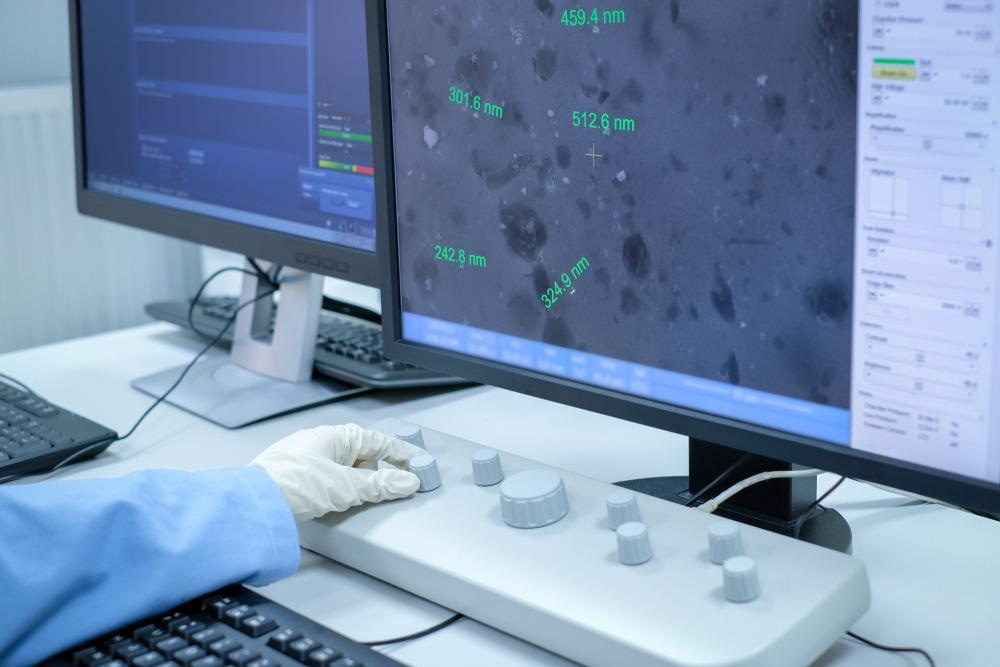To improve piezoelectric performance, a dielectric micro-capacitive method was developed by embedding well-oriented MXene (Ti3C2Tx) films in a poly(vinylidene fluoride) (PVDF) framework utilizing a scalable blade-covering process in a study available as a pre-proof in the journal Cell Reports Physical Science.

Study: Dielectric micro-capacitance for enhancing piezoelectricity via aligning MXene sheets in composites.Image Credit: Anucha Cheechang/Shutterstock.com
Different Approaches for Improving Piezoelectric Performance
Polyphase composite engineering techniques like molecular loading, polymeric grafting, and co-blending of nanoscale fillers have thus far been recognized as prevalent ways for improving the piezoelectric and dielectric characteristics of electroactive polymers.
Numerous studies and hypotheses have been developed in this area to explain the fundamental mechanics of these phenomena, and some clarity has been achieved in recent years. Trifluoroethylene (TrFE) is used as a chemical ingredient for copolymerizing with vinylidene fluoride (VDF).
TrFE monomers' tacticity promotes an ordered-to-disordered phase shift in polyvinylidene fluoride (PVDF), resulting in the formation of a morphotropic phase threshold with exceptional piezoelectric performance. Physical approaches, as opposed to chemical alterations, are more equipped to satisfy the inexpensive and scalable needs of practical uses.
Co-blending of polarized synthetic nanoparticles (NPs) with PVDF, in particular, is a physical way to boost piezoelectric effect because the composite's greater polarization may force the localized alignment of CH2–CH2 dipoles to create an all-trans TTT arrangement, leading to the enhanced piezoelectric effect. Nonetheless, this crude co-blending technique is unlikely to result in a significant function enhancement, consequently, it is critical to provide simple and highly effective ways to boost the prospects of piezoelectric composites.
Incorporating Heterogeneous Components for Better Piezoelectric Performance
The electrostriction concept, according to the traditional explanation of piezoelectricity in piezoelectric composites, provides a quantifiable comparison of the piezoelectric index as d33 = 2Q33ε0εrPr, in which d33 and Q33 represent the piezoelectricity and electrostriction coefficients, ε0 and εr represent the vacuum and relative permittivity, and Pr represents the residual polarization.
It is clear from this concept that increasing Q33, εr, and Pr may enhance the coefficient of piezoelectricity. Nonetheless, because the materials have a wide range of polarizing kinds, εr may be adjusted on a broad range, giving a larger index of piezoelectricity than that achieved by tweaking Q33 and Pr.
The insertion of heterogenized materials is an excellent strategy for this aim, since it may efficiently boost Maxwell-Wagner-Sillars polarization and therefore boost permittivity. Furthermore, this polarization is mostly determined by the permittivity differential and the heterogenized contact area in-between the two materials. As a result, heterogeneous materials with the highest aspect ratios and permittivities are preferable for improving piezoelectric and dielectric capabilities.
MXenes for Enhanced Piezoelectricity
2D conducting substances with large aspect ratios have piqued the interest of researchers. MXenes, a class of 2D materials containing many terminal groups, show promise in uses such as improved polymer compliance and variable dielectric polarization.
The composites have a good coefficient of piezoelectricity as a result of the strong electrostatic contacts among MXene films and the polymeric matrix, which may hold the polarization in fluoropolymers. Furthermore, the localized dielectric microscale capacitance created by microscale MXene films would increase the dielectric characteristics and piezoelectric behavior of the composite.
Research Strategy
A dielectric, micro-capacitive, piezoelectric solution was presented in this study by embedding well-oriented MXene films into a PVDF framework utilizing a scalable blade-covering process.
The dielectric microscale capacitance created interface polarization, which increased permittivity and resulted in a significant enhancement in the piezoelectric effect. Furthermore, a refined framework for piezo-composites was presented to elucidate the underlying process of interface polarization and dielectric relaxation influences on piezoelectricity regulation.
Important Findings of the Research
This research has offered a significant understanding of the enhancement of piezoelectricity in polymeric composites. The practical findings confirmed that the piezoelectric effect was boosted owing to the higher dielectric polarization induced by the dielectric microscale capacitance, resulting in a superior coefficient of piezoelectricity.
Crucially, the interface polarization and dielectric relaxation behaviors were considered in the piezoelectric gadget concept to better comprehend the regulatory process in piezo-composites. This suggested refined model implies that piezoelectric effect might be increased even more by boosting the interface polarization created by microscale capacitance and controlling the dielectric relaxation obtained from the conducting system.
In this study, a new technique to comprehend the electrical behavior of polymeric materials is shown, opening a path for the use of innovative composites with exceptional piezoelectric effects.
Reference
Tian, G., Deng, W. et al. (2022). Dielectric micro-capacitance for enhancing piezoelectricity via aligning MXene sheets in composites. Cell Reports Physical Science. Available at:https://www.sciencedirect.com/science/article/pii/S2666386422000844?via%3Dihub.
Disclaimer: The views expressed here are those of the author expressed in their private capacity and do not necessarily represent the views of AZoM.com Limited T/A AZoNetwork the owner and operator of this website. This disclaimer forms part of the Terms and conditions of use of this website.